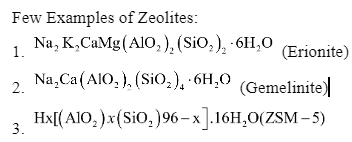Zeolites are hydrated aluminosilicate minerals composed of interconnected alumina (AlO4) and silica tetrahedra (SiO4). In layman’s terms, they’re solids made up of aluminium, oxygen, and silicon, with alkali or alkaline-Earth metals (such as sodium, potassium, and magnesium) and water molecules trapped in the gaps between them. Zeolites are made up of a variety of crystalline formations with wide open pores (also known as cavities) arranged in a regular pattern and nearly the same size as tiny molecules.
A three-dimensional tetrahedral framework in which each oxygen atom is shared by two tetrahedra is a zeolite’s most important structural property. The framework would be neutral if all tetrahedra contained silicon; however, substituting aluminium for silicon generates a charge imbalance and necessitates the presence of other metal ions in relatively significant cavities of the framework.
Types Of Zeolites:
Zeolites come in a variety of shapes and sizes. Zeolites can be synthesised or manufactured industrially, or they can be created naturally. There are about 50 different varieties of zeolites available.
![]() Chemical Composition and Structure Of Zeolites:
Chemical Composition and Structure Of Zeolites:
The aluminosilicate framework, in which silicon and aluminium are tetrahedrally coupled, is found in all zeolites. Four oxygen anions surround the silicon and aluminium cations (O2-). The building block of zeolite is the tetrahedral structure of and.
The following is a common zeolite formula:
, where
M= any one metal, which could be magnesium, sodium, potassium, lithium, or calcium.
N=the metal cation’s valence
Y=The number of water molecules in the zeolite structure.
Y/x = Si/Al atomic ratio
Structure:
In comparison to other crystalline solids, zeolite has a unique crystalline structure. Zeolite is a unique crystalline solid with a unique framework structure that has cavities filled with ions and water molecules that have a lot of freedom of movement.
Properties of Zeolites:
Under many environmental circumstances, zeolites are relatively stable solids. Zeolite has an extremely high melting point of 1000oC.
Water and other inorganic solvents do not dissolve them.
In the presence of oxygen, they do not oxidise.
The open cage-like framework structure of zeolite is a distinguishing feature that aids in the trapping of water and potassium and calcium ions.
Synthetic zeolites are made in a very precise manner with consistent pore diameters, whereas natural zeolites appear in random forms with non-uniform pore sizes.
Alumina-rich zeolites are attracted to polar molecules like water, whereas silica-rich zeolites are drawn to nonpolar molecules.
Because zeolites are non-reactive and are derived from naturally existing minerals, they have no negative environmental consequences; however, skin contact or inhalation may cause cancer.
What distinguishes zeolites from other minerals?
Zeolites are extremely stable solids that can withstand harsh environmental conditions that many other materials can’t. They are unaffected by high heat because they have relatively high melting points (above 1000oC) and do not burn.
They also withstand high pressures, do not dissolve in water or other inorganic solvents, and do not oxidise when exposed to air.
They aren’t thought to cause health problems through skin contact or inhalation, yet they may have carcinogenic (cancer-causing) properties in fibrous form.
They’re thought to have no negative environmental effects because they’re non-reactive and made from naturally available minerals. Although the fact that zeolites are stable and non-reactive may appear to be a drawback, this isn’t the case.
Zeolites are known for their open, cage-like “framework” structure and ability to trap other molecules inside them. Water molecules and alkali or alkaline-Earth metal ions (positively charged atoms with too few electrons, also known as cations) form a component of zeolite crystals in this way, however they don’t always stay there.
Zeolites can swap other positively charged ions for the metal ions trapped inside them (officially known as cation exchange), and they can easily gain or lose water molecules, as Cronstedt discovered over 250 years ago (this is called reversible dehydration).
Zeolites contain regular, fixed-size pores that allow small molecules to pass through but trap larger molecules; this is why they’re frequently called molecular sieves.
Conclusion:
Zeolites are three-dimensional crystalline solids of aluminium silicate that are microporous. Zeolites feature small, fixed-size pores that allow small molecules to pass through readily but not larger molecules; this is why they are frequently referred to as molecular sieves.
Commercial zeolites with specific structural and chemical properties are used to leverage zeolite capabilities. Separation of hydrocarbons, such as in petroleum refining; drying of gases and liquids; and pollution management via selective molecule adsorption are some of the commercial applications.
 Profile
Profile Settings
Settings Refer your friends
Refer your friends Sign out
Sign out











 Chemical Composition and Structure Of Zeolites:
Chemical Composition and Structure Of Zeolites:

